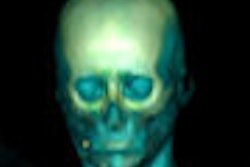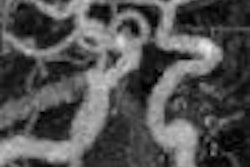Trained but inexperienced readers of coronary CT angiography (CTA) studies improved their performance significantly over a year's time, though they fell short of expert readers' results, according to a study from Erasmus University Medical Center in Rotterdam, Netherlands. The study suggests that coronary CTA training programs lasting less than one year may be too short.
How does experience affect accuracy in newly minted radiologists and cardiologists? Some evidence suggests that higher case volumes and length of experience improve performance, but the effect is not uniform among readers, said Dr. Francesca Pugliese in a presentation at the 2008 European Congress of Radiology (ECR) in Vienna.
Intensive, focused training is also critical for success. "According to the American College of Radiology (ACR), a radiologist is qualified to read the full set of images after (a multislice CT) training period," Pugliese said.
To evaluate the effects of experience and increasing exposure to coronary CTA exams, the study was performed on four fellows -- three radiologists and one cadiologist -- who had been accepted for a year's training in a dedicated cardiac CT unit of the hospital. Their diagnostic performance was measured and compared over the course of the year.
The readers had no prior experience with coronary CTA, but they received feedback and training before the evaluation period by three independent, experienced radiologists in interpreting 15 mentored cases. They also attended lectures on cardiac anatomy and on coronary CTA technique.
The radiologists were responsible for all aspects of acquisition and interpretation of coronary CTA studies (12 to 15 per week). They read 50 cases independently during the initial four weeks of the study, from eight weeks to six months they read an additional 150 cases, and from six months to one year they read an additional 300 cases, for a total of nearly 600 cases each during the year (592 and 593 cases in each of two rotations of fellows, respectively).
Demographics and disease prevalence were approximately equivalent between the study periods; 76% of the patients (mean age 59) had at least one occluded coronary artery segment, Pugliese said. Conventional angiography served as the reference standard for results.
"Cases were scored at baseline, four weeks, eight weeks, six months, and one year," she said. "The cases were anonymized, randomized, and the fellows did not receive feedback about their performance."
As for reconstructions, trainees were able to evaluate 2D images, multiplanar reconstructions (MPRs), and maximum intensity projections (MIPs) on their syngo 3D workstation (Siemens Healthcare, Erlangen, Germany) but were not permitted to use quantitative software. All findings were recorded according to the 17-segment American Heart Association model, Pugliese said.
Sensitivity, specificity, and negative predictive value after one year were all significantly better than those after six months (p < 0.05), Pugliese said. The diagnostic odds ratio was 6.4 at the study outset, 9.1 after six months, and 18.7 after one year.
|
Although all readers improved over time, the rate of progress depended on the reader and was definitely "not linear," she said.
"Between baseline and six months, three readers improved sensitivity and one reader improved specificity, but not significantly," she said. "All readers improved diagnostic accuracy (during the first six months), but not significantly. Between baseline and one year, two readers improved sensitivity, one significantly, and four readers improved their specificity, but not significantly."
On the other hand, all readers improved their evaluation times significantly, from an average of 26 minutes per case at baseline to 11.9 minutes at one year, she added.
Performance at one year was comparable but not equal to that of expert readers in published studies, a finding Pugliese attributed to publication bias that favors successful studies from select institutions and the long learning curve for coronary CTA.
The interpretative learning curve in cardiac CT is not rapid, and competence cannot be assumed after a six-month training period, the researchers concluded. In fact, Pugliese said, "it might take more than one year for a beginner to achieve expert competence based on our experience."
In response to a question from the audience regarding how the study results might inform training programs, Pugliese said that future programs will devote more time to mentoring trainees on the consequences of overcalling and undercalling findings.
By Eric Barnes
AuntMinnie.com staff writer
April 28, 2008
Related Reading
Voice recognition key to fast report turnaround, April 24, 2008
First 320-slice coronary CTA study shows high image quality, April 7, 2008
Cardiac CT saves money and time as first-line heart test, April 1, 2008
ACCURACY trial compares coronary CTA to angiography, January 18, 2008
Cardiology societies adopt cardiac CT, MR standards, August 2, 2005
Copyright © 2008 AuntMinnie.com




















